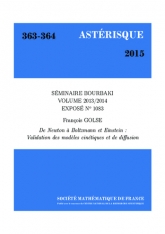Exposé Bourbaki 1083 : De Newton à Boltzmann et Einstein : Validation des modèles cinétiques et de diffusion
Exposé Bourbaki 1083 : From Newton to Boltzmann and Einstein : a derivation of diffusion and kinetic models

- Consulter un extrait
- Année : 2015
- Tome : 367-368
- Format : Électronique
- Langue de l'ouvrage :
Français - Class. Math. : 35Q20, 82A70 (35Q70,82B40,82C22.
- Pages : 285-326
- DOI : 10.24033/ast.949
La théorie cinétique des gaz de Maxwell et Boltzmann s'est trouvée au cœur de controverses scientifiques majeures. L'incompatibilité supposée entre le caractère réversible des équations de la mécanique ique et l'augmentation de l'entropie, qui, dans le cadre de la théorie cinétique des gaz, est une propriété mathématique de l'équation de Boltzmann connue sous le nom de théorème H, était l'un des arguments couramment utilisés contre la validité de cette théorie. Il a fallu attendre environ un siècle pour que O. Lanford propose, en 1974, une stratégie de preuve permettant de démontrer que l'équation de Boltzmann décrit une certaine limite asymptotique des équations de Newton de la mécanique ique pour un système formé d'un très grand nombre $N$ de particules sphériques identiques n'interagissant qu'au cours de collisions élastiques. Un travail récent de I. Gallagher, L. Saint-Raymond et B. Texier précise la preuve de Lanford et l'étend au cas où l'interaction entre particules est décrite par un potentiel à très courte portée. Un article ultérieur de T. Bodineau, I. Gallagher et L. Saint-Raymond étudie ensuite la dynamique d'une particule marquée parmi $N$ dans la même limite asymptotique, établissant ainsi la validité de l'équation de Boltzmann linéaire sur un intervalle de temps dont la longueur tend vers l'infini avec $N$. En utilisant des résultats aujourd'hui iques sur la théorie asymptotique de l'équation de Boltzmann linéaire, les mêmes auteurs démontrent que le processus stochastique connu sous le nom de mouvement brownien décrit une certaine limite de la dynamique déterministe de particules en interaction.

